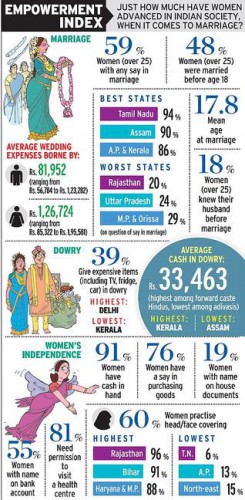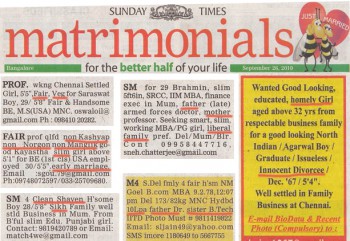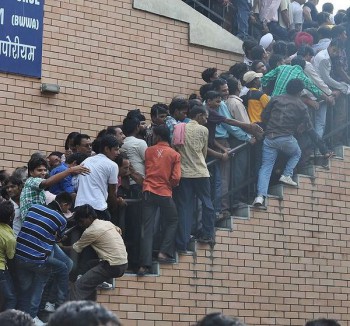04/16/2014
The Indian wedding for Dummies - 2. Finding a suitor
The "Indian wedding" (I should say the Hindu wedding to be exact) has made the subject of numerous books, movies, visits to India. In short it’s an institution. I will try here to understand something to it!
When it is decided to put such son or such daughter on the market, the family prepare a resume and letter of motivation – I'm not kidding, my ex-boyfriend was super happy when he received a spontaneous application even though 1. He was not officially “available” for marriage and 2. He thought his reputation was ruined because he was dating a foreigner.
Then they activate social networks (and here I am not speaking of facebook but of the original networks, which have incredible proportions among Indians, who are able to talk to anyone anywhere and make friends in five minutes.
There is also the tradition of the nayan, the matchmaker (source) It is usually a friend or a distant relative, neutral, having a talent as a recruiter (to find the unique one) and as a negotiator (to succeed in having both parties agreeing to the “terms” of the marriage (although the dowry is illegal in India since 1961, it is commonplace that the family “buys” the guy – I gift you a nice car if (please, please, please) you marry my daughter).
They also publish matrimonial ads in newspapers:
Today they also register on marriage websites.
The family astrologer is also involved. While we are at it, you should know that in India, the astrologer isn't considered as a charlatan but rather as a pillar in the life of every good Hindu: birth first, marriage then (that's why on invitation cards, the time is very precise, like 9:46 AM; is not a typo mistake but the exact time when the starts will cross path!) and then at any other important moment. For instance, one of my best managers shifted his interview for a few days, so that the planets would be aligned. So be it. Hindus even grant astrologers with the benefit of mistakes and don’t hesitate to consult several experts to get the real truth. Astrologers are also a bit magicians because when the alignment is messed up, they have the chance to correct it. So sometimes the horoscopes of a couple don’t match and the horoscope the bride predicts that her first husband will die young (she is called manglik). The trick is to marry her to a tree or an earthen pot, which then are destroyed (or immerged for the second), leaving her a widow, and free to remarry without bringing bad luck to her human husband. It has happened to some of my friends... And here's a great post by an Indian blogger on this rite (pdf) and incidentally on all her experiences as a modern dating Indian girl (blog).
08:00 Posted in Incredible India!, Why in India... | Permalink | Comments (0) | Tags: india, marriage, wedding, arranged marriage, forced marriage, love marriage, rites, ceremonies, rituals, divorce, sheet, mehndi, henna, baraat, sex, incompatibility, contract, classifieds, matrimonials, matchmaker, nayan, astrologers, horoscope, marry a tree, marry a pot, auspicious, date, joint family, kama sutra | ![]() Facebook | |
Facebook | |
04/14/2014
The Indian wedding for Dummies - 1. The arranged marriage
The "Indian wedding" (I should say the Hindu wedding to be exact) has made the subject of numerous books, movies, visits to India. In short it’s an institution. I will try here to understand something to it!
Arranged marriage: and why not?!
Let's make the distinction between arranged marriage and forced marriage.
 If I can de-dramatize arranged marriages (read below), it is impossible to do the same with forced marriages which are still widely practiced in India: 40% of women do not have a word in the choice of the husband, less than 20% of women (over 25) knew their husbands before the fateful day and worse, almost 50% of women have married before the legal age of 18 (source).
If I can de-dramatize arranged marriages (read below), it is impossible to do the same with forced marriages which are still widely practiced in India: 40% of women do not have a word in the choice of the husband, less than 20% of women (over 25) knew their husbands before the fateful day and worse, almost 50% of women have married before the legal age of 18 (source).
Which means that there are still thousands of people (Hindus) who, each year, follow the tradition and find out whom they are going spend the rest of their lives with only when they are already married: SURPRISE! As per the custom to groom arrives first, and his view is hidden with a bed sheet, which is removed once the bride is brought in by her maternal uncle and cousins and the consent of the parents exchanged. The bed sheet is simply a less sexy version (but more promising ;)) of the veil used in Catholic marriages, originally to hide the face of the bride (source).
The concept of arranged marriage, still very prevalent in India (more than 90% of cases), tends to shock the Westerners. Before crying wolf and saying Indians are horrible, remember that from the time of Ancient Rome to the 19th century (i.e. 2 500 small years), the marriage of convenience was the norm in our civilization. The family was then a “business of social or economic survival” and marriage a “contract” to ensure its sustainability*.
What about love in an arranged marriage? When a Westerner thinks of arranged marriage, he immediately gets the image of a pretty girl forced to marry a loser, too ugly and too stupid to find a woman by himself! While in fact, parents seek someone who matches as much as possible – and we can assume that they know their offspring pretty well! And the candidate has a whole lot of criteria to fill: religion, caste, skin colour (fairness being an essential criterion of beauty), income, location, diet (non-vegetarien vs vegetarian), horoscope to mention only but the most important.
Whatever said and done, it is likely that two “virgins of love”, that many things draw close (see above-mentioned criteria), which have been waiting for it since childhood, end up loving each other (they so want it!). The passion, the ignition of the body and desire, is less guaranteed but at the same time it is known to be ephemeral, isn’t it? ;)
Let's be honest: who has never felt, while celibacy and the thirties are at their full, as meetings on the Internet have only led to failures (ending up, at best, as entertaining sex buddies), as the stock of single friends’ friends is exhausted, when the anxiety of ending up as a lonely spinster eaten by her cat makes the ball in your throat so big even Häagen-Dazs doesn’t get down anymore : “if only my awesome parents who have (almost) always fulfilled my whims could find me the perfect match!” Who did not want to make this call, unthinkable, and yet potentially life-saving?!
In the same vein, it is a bit hypocritical to criticize arranged marriage when you see the success of online dating sites in the West (in 2007, 1 out of 8 married couple in the US met online! source)).
And then even if it is not written black on white, if it is not man-da-tory, despite our increasingly multicultural environments, we are still largely endogamic – most of my friends have married people from their tribe, and it is certainly easier to manage than for the eccentrics who get a partner from another country, another colour, another religion or another social class. Easier because two endogamic people only have to overcome the differences due to gender and personality and not all the others. But it is also probably less outlandish, enriching and rewarding!
So when you dig a little, you realize that what mostly shocks my fellow Westerners is not so much the “arrangement” itself but rather the idea of not having “tested the goods before purchase”, ending up on the wedding night in bed with an unknown person... I admit that in our culture where sex is ubiquitous, obsessive, glorified, overvalued (?), the idea is off-putting. In addition it is a bad one if I take the example of my (Indian) close friends’ experiences: unconsumed union, weird practices, very often the man is not “up to the mark” and this up till the divorce! Seeing a young couple on honeymoon who has nothing to say to each other in the first days (before things warm up) surprises me every time, and makes me reflect on the oddity (from my point of view) of the situation.
And yet it is still the rule. For the lucky ones, the “choice” to refuse an application is becoming increasingly available. So is the option to introduce someone (from school, from the office) and if the afore-mentioned criteria are met and that the union takes place, it will be called a “love marriage” (even if very often, there is no romantic relationship). Real love marriages, guided by passion and defying the afore-mentioned criteria, remain very rare and often end up in bloodshed (especially in under-privileged backgrounds).
That is why passion is exalted as the Holy Grail (something you dream of but will never get) in the movies, and in families as a trouble maker (the uncontrollable versus the social codes that govern a well-ordered life).
* “It is during the 18th century that the family ceased to be regarded as a business of social survival or economic to rely more and more on the feeling of love [...] The mentioned change was influenced by economic factors such as industrialization, opening markets, wage labour, the progressive improvement of conditions of life, but also by an encouragement of the Church and the State. […] We can see, for example, that today, despite the diversification of modern societies which are often multicultural, a trend quite generalized to contract endogamic marriages; the choice of the partner is often influenced by social origin, ethnic, racial or religious.” Source: http://www.asblcefa.be/cefa/images/pdf/9mariagearrange
“Marriage is first a contract between a man and a woman. Subsequently, free consent developed, and marriage for love gradually override the marriage of convenience during the nineteenth century, in parallel with the evolution of the role of women in society, aimed to being the equal of men. This process culminated with the legalization of divorcein 1884. » Source: http://www.mariages.net/articles/origines-et-histoire-du-mariage--c5102
08:00 Posted in Incredible India!, Why in India... | Permalink | Comments (0) | Tags: india, marriage, wedding, arranged marriage, forced marriage, love marriage, rites, ceremonies, rituals, divorce, sheet, mehndi, henna, baraat, sex, incompatibility, contract, classifieds, matrimonials, matchmaker, nayan, astrologers, horoscope, marry a tree, marry a pot, auspicious, date, joint family, kama sutra | ![]() Facebook | |
Facebook | |
01/24/2014
Waiting in line? But what line??
It all began with an innocent question asked at breakfast by my new favorite Indian: “Tell me, all the French are as close to their family as you are? I was wondering, because Westerners are known to be individualistic, you know, so it’s a bit confusing... »
And BAM take that in the face! But I managed to keep my cool and patiently listen to his explanations of the Indian concept of the family which takes precedence over the individual.
On the other hand I did not miss him a few weeks later, with a formidable smash: “The next time you tell me Westerners are individualistic (as opposed to Indians), I send you to the ladies’ line for bag screening with the Indian women, non mais attends!”
We have all experienced it in India, and not only once, and at various levels... You are waiting in line to put your bag on the belt and an Indian woman, and then another Indian woman, just cut the line under your nose… Like nothing has happened...
Yes, it happens in every line, or almost. Except that this time, to help the women who were being cut and getting upset but not daring to say anything, I used my body to block access to the belt and then BAM! an Indian woman threw her bag over my shoulder! The security man had the goodness to interfere before the ladies threw themselves at each other...
So you start wondering. Assholes who see a line and cut it exist everywhere – the French even have quite a reputation as experts in line cutting! But in this case? It was not a typical case of assholes-cutting-the-line, so what??
A plausible explanation to this common behavior in India would be the fact that demand is superior to the supply for almost everything here, due to the urban overpopulation: somehow they have to fight for everything. For instance, it is out of question to wait in a line to get into a local train in Mumbai, otherwise you can spend the night on the quay. It is much more recommended to step on your neighbors’ heads. But well, at the airport the scenario is quite not the same...
I was very curious to understand what goes on in the heads of these women who see people waiting in a line and simply and purely ignore it. And my favorite Indian cared to give me an explanation, a very simple one:
- “They must have things to do in the destination place and are in a rush to go.
- But me too I have things to do, they can’t think of that?
- Then they must assume that what they have to do and hence their flight is more important than yours.”
And booooom! Who is individualistic now huh darling??! Maybe most of human beings think they come first in this world no?
We finally discussed this topic a bit further. It appears that Indians and French probably have the same attachment to their family.
In France, we are ‘individualists’ in the sense that we are looking for our personal happiness – we put ourselves before the society; but isn’t it a necessary condition to make our loved ones happy (being happy yourself)? And God knows that this individual pursuit of happiness is not easy... And that’s how, at eighteen we leave home to go dig our own path and build our own nest. This is not running away from our responsibilities (as it is perceived here), but quite the contrary.
In India, it has more to do with order; there is a whole lot of rules (religious, social order, family order) and making sure this order is not disturbed is what seems to make them happy (or at least free of guilt for doing the wrong thing). And that’s how they live their entire lives with their parents and that, past the golden age of childhood, they start working at repaying their parents for everything they have done for them. But it doesn’t cost them because their children will do the same! Their life is kind of pre-written: you will study this, start working at this age, marry at this age etc. and doing this will make your family happy so you just go for it. Not everybody follows that of course.
Their killer argument (or so they believe) to defend the Indian system is the divorce rates and elderly being dumped in homes in the West. Which leads them to assume that family means nothing to us...
Take the French statistics. If half of the marriages end up in a divorce, it is mainly at the request of women, and especially the active woman (1). A sign that becoming independence enables women to take less crap? Far from me the idea of advocating for divorce which, in my opinion, remains a traumatic event, even if more and more commonplace. But maybe it is a blessing in disguise, if women are happier then... And anyway it is the way it is! In conclusion, it is not so much that the family does not count for us, it is that the concept of the family evolves... For us, a couple who lives together without being married is a family. In India it was a crime up to 2010 (2). But it has been slowly changing, at the pace of the ‘Indian elephant’ (whose economy is growing slowly but surely, bringing along its societal changes...) (3).
And as far as the elderly are concerned, if getting rid of them by sending them in hospices is nothing glorious, all retirement homes are not the same and also very few elderly actually live in such facilities – among the 75-79 years, only 3% live in institutions for elderly persons in France (4). And in fact, the number of homes where old people live in a place adapted to their movements, with proper medical assistance, activities, and buddies, has been exploding in India (5). I am always surprised when my Indian friends tell me about the family members living with them and mention a grandfather almost invalid who stays parked in his room the whole day and is the charge of a family member (without medical qualifications).
(1) In France, in 2011, 44.7% of marriages end up in a divorce. In 3 out of 4 cases, the applicant's divorce are women and 68% of the women divorcing have a professional activity. The type of divorce in France has also heavily changed: divorce by mutual consent reached 54% in 2010. Source: http://www.planetoscope.com/lamour/1062-nombre-de-nouveaux-divorces-en-france.html; global statistics and fun facts: http://www.huffingtonpost.com/2012/06/01/divorce-rate-how-well-do-_n_1562900.html
(2)http://www.liveintogether.com/live-in-laws-India.asp
(3) http://www.huffingtonpost.com/2011/04/12/india-divorce-rate-rise_n_848201.html
(4) Among the 90-99 years, 22% of men and 37% of women live in a facility for the elderly. Source: http://www.lesmaisonsderetraite.fr/maisons-de-retraite/chiffres-statistiques.htm
08:00 Posted in Incredible India!, My stories in India, Why in India... | Permalink | Comments (0) | Tags: india, west, individualist, individualistic, behavirour, line, waiting in line, line-cutting, marriage, divorce, elderly | ![]() Facebook | |
Facebook | |
















